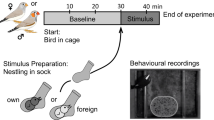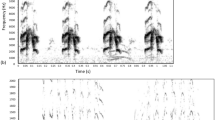Abstract
Although it has long been disregarded, the accumulating evidence suggests that birds use chemical cues for communication. However, the impact of olfaction on avian mate choice and its potential function in inbreeding avoidance remain unknown. We compared the mate choice and reproductive behaviour between females experimentally deprived of their sense of smell and intact control females. Each female was allowed to mate with two unfamiliar males, an unrelated male and a full brother. If olfactory cues are involved in kin recognition and/or mate choice, we expect the smelling females to reproduce with the unrelated males and the anosmic females to mate randomly with respect to relatedness. The paternity analysis revealed that the anosmic females reproduced randomly with respect to relatedness. Contrary to our expectations, the females with an intact olfactory mucosa demonstrated a decrease in reproduction; they produced significantly fewer eggs than the anosmic females, and the chicks in only one of the cages reached independence. Thus, the female’s ability to smell in the presence of the unfamiliar brother had the unexpected effect of impairing the reproductive behaviour of the females. This is the first study to report directly the critical role of olfactory signals in reproduction and its potential function in preventing maladaptive breeding attempts with kin in female songbirds.


Similar content being viewed by others
References
Amo L, Galvan I, Tomas G, Sanz JJ (2008) Predator odour recognition and avoidance in a songbird. Funct Ecol 22:289–293
Amo L, Visser ME, van Oers K (2011) Smelling out predators is innate in birds. Ardea 99:177–184
Amo L, Avilés JM, Parejo D, Peña A, Rodríguez J, Tomás G (2012a) Sex recognition by odour and variation in the uropygial gland secretion in starlings. J Anim Ecol 81:605–613
Amo L, López-Rull I, Pagán I, Macías Garcia C (2012b) Male quality and conspecific scent preferences in the house finch, Carpodacus mexicanus. Anim Behav 84:1483–1489
Arct A, Rutkowska J, Martyka R, Drobniak SM, Cichoń M (2010) Kin recognition and adjustment of reproductive effort in zebra finches. Biol Lett 6:762–764
Bang BG (1960) Anatomical evidence for olfactory function in some species of birds. Nature 188:547–549
Bang BG, Cobb S (1968) The size of the olfactory bulb in 108 species of birds. Auk 85:55–61
Barrett J, Abbott DH, George LM (1990) Extension of reproductive suppression by pheromonal cues in subordinate female marmoset monkeys, Callithrix jacchus. J Reprod Fertil 90:411–418
Benvenuti S, Gagliardo A (1996) Homing behaviour of pigeons subjected to unilateral zinc sulphate treatment of their olfactory mucosa. J Exp Biol 199:2531–2535
Benvenuti S, Ioalè P, Gagliardo A, Bonadonna F (1992) Effects of zinc sulphate-induced anosmia of homing behaviour of pigeons. Comp Biochem Phys A 103:519–526
Bolund E, Martin K, Kempenaers B, Forstmeier W (2010) Inbreeding depression of sexually selected traits and attractiveness in the zebra finch. Anim Behav 79:947–955
Bonadonna F, Sanz-Aguilar A (2012) Kin recognition and inbreeding avoidance in wild birds: the first evidence for individual kin-related odour recognition. Anim Behav 84:509–513
Boulet M, Charpentier MJ, Drea CM (2009) Decoding an olfactory mechanism of kin recognition and inbreeding avoidance in a primate. BMC Evol Biol 9:281
Buitron D, Nuechterlein GL (1985) Experiments on olfactory detection of food caches by black-billed magpies. Condor 87:92–95
Caro SP, Balthazart J (2010) Pheromones in birds: myth or reality? J Comp Physiol A 196:751–766
Caro SP, Balthazart J, Bonadonna F (2015) The perfume of reproduction in birds: chemosignaling in avian social life. Horm Behav 68:25–42
Caspers BA, Krause ET (2011) Odour-based natal nest recognition in the zebra finch (Taeniopygia guttata), a colony-breeding songbird. Biol Lett 7:184–186
Caspers BA, Krause ET (2013) Intraspecific olfactory communication in zebra finches (Taeniopygia guttata): potential information apart from visual and acoustic cues. In: East ML, Dehnhard M (eds) Chemical signals in vertebrates 12. Springer, New York, pp 341–351
Caspers BA, Hoffman JI, Kohlmeier P, Krüger O, Krause ET (2013) Olfactory imprinting as a mechanism for nest odour recognition in zebra finches. Anim Behav 86:85–90
Célérier A, Bon C, Malapert A, Palmas P, Bonadonna F (2011) Chemical kin label in seabirds. Biol Lett 7:807–810
Crnokrak P, Roff DA (1999) Inbreeding depression in the wild. Heredity 83:260–270
Dawson DA, Chittock J, Jehle R, Whitlock A, Nogueira D, Pellatt J, Birkhead T, Burke T (2005) Identification of 13 polymorphic microsatellite loci in the zebra finch, Taeniopygia guttata (Passeridae, Aves). Mol Ecol Notes 5:298–301
Forstmeier W, Schielzeth H, Schneider M, Kempenaers B (2007) Development of polymorphic microsatellite markers for the zebra finch (Taeniopygia guttata). Mol Ecol Notes 7:1026–1028
Gagliardo A (2013) Forty years of olfactory navigation in birds. J Exp Biol 216:2165–2171
Gerlach G (2006) Pheromonal regulation of reproductive success in female zebrafish: female suppression and male enhancement. Anim Behav 72:1119–1124
Gwinner H, Berger S (2008) Starling males select green nest material by olfaction using experience-independent and experience-dependent cues. Anim Behav 75:971–976
Hagelin JC, Jones IL, Rasmussen LEL (2003) A tangerine-scented social odour in a monogamous seabird. Proc R Soc Lond B 270:1323–1329
Hamilton WD (1964) The genetical evolution of social behaviour. I J Theor Biol 7:1–16
Hatchwell BJ (2009) The evolution of cooperative breeding in birds: kinship, dispersal and life history. Philos Trans R Soc B 364:3217–3227
Hemmings NL, Slate J, Birkhead TR (2012) Inbreeding causes early death in a passerine bird. Nat Commun 3:863
Hepper PG (1991) Kin recognition. Cambridge University Press, Cambridge
Holland RA et al (2009) Testing the role of sensory systems in the migratory heading of a songbird. J Exp Biol 212:4065–4071
Ihle M, Forstmeier W (2013) Revisiting the evidence for inbreeding avoidance in zebra finches. Behav Ecol 24:1356–1362
Keller LF, Waller DM (2002) Inbreeding effects in wild populations. Trends Ecol Evol 17:230–241
Komdeur J, Hatchwell BJ (1999) Kin recognition: function and mechanism in avian societies. Trends Ecol Evol 14:237–241
Krakauer AH (2005) Kin selection and cooperative courtship in wild turkeys. Nature 434:69–72
Krause ET, Caspers BA (2012) Are olfactory cues involved in nest recognition in two social species of estrildid finches? PLoS ONE 7, e36615
Krause ET, Krüger O, Kohlmeier P, Caspers BA (2012) Olfactory kin recognition in a songbird. Biol Lett 8:327–329
Krause ET, Brummel C, Kohlwey S, Baier MC, Müller C, Bonadonna F, Caspers BA (2014) Differences in olfactory species recognition in the females of two Australian songbird species. Behav Ecol Sociobiol 68:1819–1827
Leclaire S, Merkling T, Raynaud C, Mulard H, Bessière JM, Lhuillier E, Hatch SA, Danchinet E (2012) Semiochemical compounds of preen secretion reflect genetic make-up in a seabird species. Proc R Soc Lond B 279:1185–1193
Leclaire S, van Dongen WFD, Voccia S, Merkling T, Ducamp C, Hatch SA, Blanchard P, Danchin E, Wagner RH (2014) Preen secretions encode information on MHC similarity in certain sex-dyads in a monogamous seabird. Sci Rep 4:6920
Metzger M, Bernstein C, Hoffmeister TS, Desouhant E (2010) Does kin recognition and sib-mating avoidance limit the risk of genetic incompatibility in a parasitic wasp? PLoS ONE 5, e13505
Miazzi F (2012) The importance of visual, acoustic and olfactory cues in female mate choice in a monogamous songbird, the zebra finch (Taeniopygia guttata). Master thesis. Pisa University, Italy
Nevitt GA, Bonadonna F (2005) Sensitivity to dimethyl sulphide suggests a mechanism for olfactory navigation by seabirds. Biol Lett 1:303–305
Papi F (1989) Pigeons use olfactory cues to navigate. Ethol Ecol Evol 1:219–231
Petit C, Hossaert-McKey M, Perret P, Blondel J, Lambrechts MM (2002) Blue tits use selected plants and olfaction to maintain an aromatic environment for nestlings. Ecol Lett 5:585–589
Petrie M, Krupa A, Burke T (1999) Peacocks lek with relatives even in the absence of social and environmental cues. Nature 401:155–157
Pusey A, Wolf M (1996) Inbreeding avoidance in animals. Trend Ecol Evol 11:201–206
Roper TJ (1999) Olfaction in birds. Adv Study Behav 28:247–332
Roth TC, Cox JG, Lima SL (2008) Can foraging birds assess predation risk by scent? Anim Behav 76:2021–2027
Schneider MA, Hendrix L (2000) Olfactory sexual inhibition and the Westermarck effect. Hum Nat 11:65–91
Schubert CA, Ratcliffe LM, Boag PT (1989) A test of inbreeding avoidance in the zebra finch. Ethology 82:265–274
Silcox AP, Evans SM (1982) Factory affecting the formation and maintenance of pair bonds in the zebra finch, Taeniopygia guttata. Anim Behav 30:1237–1243
Stoffel M, Caspers BA, Forcada J, Giannakara A, Baier MC, Eberhart-Phillips LJ, Müller C, Hoffman JI (2015) Chemical fingerprints encode mother-offspring similarity, colony membership, relatedness and genetic quality in fur seals. Proc Natl Acad Sci U S A. doi:10.1073/pnas.1506076112
Waldman B (1985) Olfactory basis of kin recognition in toad tadpoles. J Comp Physiol 156:565–577
Wenzel BM (1968) Olfactory prowess of Kiwi. Nature 220:1133–1134
Whittaker DJ, Soini HA, Atwell JW, Hollars C, Novotny MV, Ketterson ED (2010) Songbird chemosignals: volatile compounds in preen gland secretions vary among individuals, sexes, and populations. Behav Ecol 21:608–614
Whittaker DJ, Gerlach NM, Soini HA, Novotny MV, Ketterson ED (2013) Bird odour predicts reproductive success. Anim Behav 86:697–703
Zann RA (1996) The zebra finch: a synthesis of field and laboratory studies. Oxford University Press, Oxford
Zelano B, Edwards SV (2002) An MHC component to kin recognition and mate choice in birds: predictions, progress, and prospects. Am Nat 160:S225–S237
Zhang YH, Du YF, Zhang JX (2013) Uropygial gland volatiles facilitate species recognition between two sympatric sibling bird species. Behav Ecol 24:1271–1278
Acknowledgments
This study was financially supported by a research grant from the Ethologische Gesellschaft e.V. to BAC. ETK was funded by the Volkswagen Foundation (85994). BAC is currently a Freigeist Fellow funded by the Volkswagen Foundation. We thank Elke Hippauf for technical assistance and Ulla Kodytek, Gitta Otte and Kristina Ruhe for caring for the animals.
Conflict of interest
The authors declare that they have no competing interests.
Ethical standards
The experiments were conducted with the permission of the North Rhine-Westphalia State Agency for Nature, Environment and Consumer Protection (permit number LANU NRW Az: 8.87-51.05.20.11.042). The housing and breeding of the birds were conducted with the permission of the Veterinäramt Bielefeld, Germany (Az: 530.421630-1, 18.04.2002). All birds remained in the lab stock after the experiment was completed.
Author information
Authors and Affiliations
Corresponding author
Additional information
Communicated by D. Rubenstein
Barbara A. Caspers and E. Tobias Krause contributed equally to this work.
Rights and permissions
About this article
Cite this article
Caspers, B.A., Gagliardo, A. & Krause, E.T. Impact of kin odour on reproduction in zebra finches. Behav Ecol Sociobiol 69, 1827–1833 (2015). https://doi.org/10.1007/s00265-015-1995-9
Received:
Revised:
Accepted:
Published:
Issue Date:
DOI: https://doi.org/10.1007/s00265-015-1995-9




